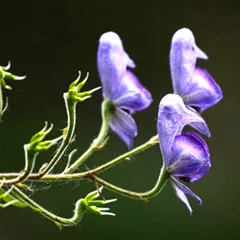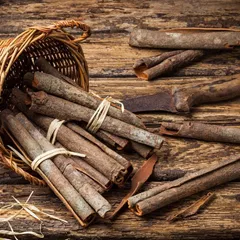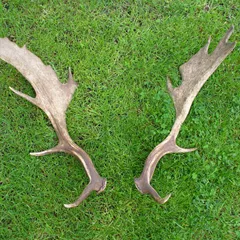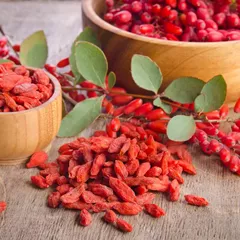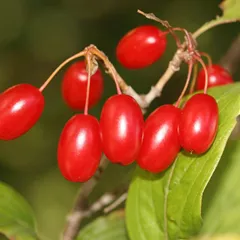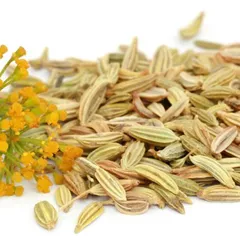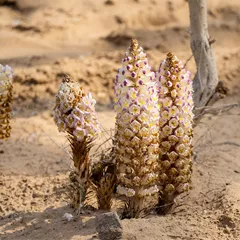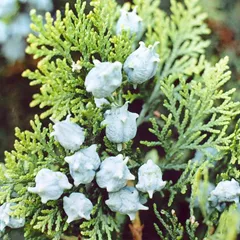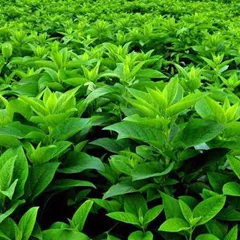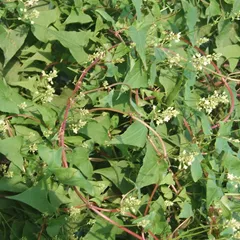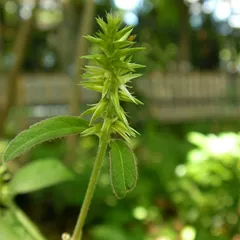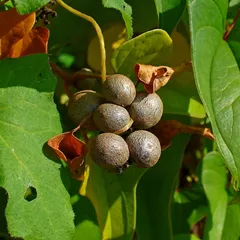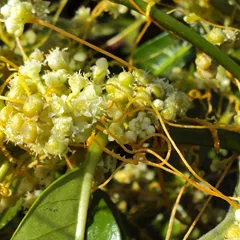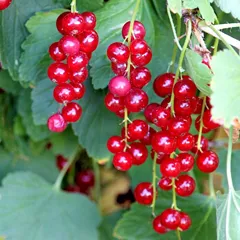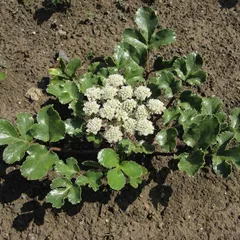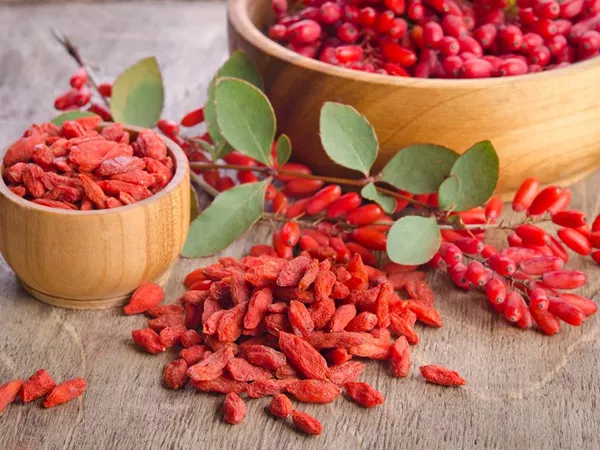
Gou Qi Zi
Gou Qi Zi
English: Goji berries
Chinese: 枸杞子
Parts used: Dried ripe fruit
TCM category: Tonic herbs for Yin Deficiency
TCM nature: Neutral
TCM taste(s): Sweet
Scientific name: Lycium barbarum or Lycium chinense
Other names: Chinese wolfberry, Lycii berry
Use of Gou Qi Zi (goji berries) in TCM
Please note that you should never self-prescribe TCM ingredients. A TCM ingredient is almost never eaten on its own but as part of a formula containing several ingredients that act together. Please consult a professional TCM practitioner, they will be best able to guide you.
Preparation: Pick the fruit when it is ripe, remove the stem and dry in the shade until wrinkles appear.
Dosage: 2 to 4 fruits
Main actions according to TCM*: Tonifies the Yin of the Liver and Yin of the Kidneys. Brightens the eyes. Moistens the Lungs.
Primary conditions or symptoms for which Gou Qi Zi may be prescribed by TCM doctors*: Knee pain Tinnitus Diabetes Anemia Impaired vision
Contraindications*: Should not be used by those with patterns of Heat and Excess, nor should it be used when there is Spleen Deficiency with Dampness or loose stools. Unidentified Goji berry phytochemicals may inhibit metabolism of other medications, such as those processed by the cytochrome P450 liver enzymes. Such drugs include Warfarin, or drugs for diabetes or hypertension.
Common TCM formulas in which Gou Qi Zi is used*
You Gui Wan
Source date: 1624 AD
Number of ingredients: 10 herbs
Formula key actions: Warms and tonifies Kidney Yang. Replenishes the Essence. Tonifies the Blood.
Conditions targeted*: Nephrotic syndromeOsteoporosis and others
Gou Qi Zi is a deputy ingredient in You Gui Wan. This means it helps the king ingredient(s) treat the main pattern or it serves to treat a coexisting pattern.
Zuo Gui Wan
Source date: 1624 AD
Number of ingredients: 8 herbs
Formula key actions: Nourishes the Yin. Strengthens the Kidneys. Fills the Essence. Augments the marrow.
Conditions targeted*: Chronic bronchitisChronic nephritis and others
Gou Qi Zi is a deputy ingredient in Zuo Gui Wan. This means it helps the king ingredient(s) treat the main pattern or it serves to treat a coexisting pattern.
In Zuo Gui Wan, Gou Qi Zi nourishes the Liver Blood. Together with Shan Zhu Yu, they work synergistically with the chief herb Shu Di huang.
Zuo Gui Yin
Source date: 1624 AD
Number of ingredients: 6 herbs
Formula key actions: Nourishes the Yin. Tonifies the Kidneys.
Gou Qi Zi is a deputy ingredient in Zuo Gui Yin. This means it helps the king ingredient(s) treat the main pattern or it serves to treat a coexisting pattern.
In Zuo Gui Yin, Gou Qi Zi nourishes the Liver Blood. Together with Shan Zhu Yu, they work synergistically with the chief herb Shu Di huang.
Nuan Gan Jian
Source date: 1624 AD
Number of ingredients: 8 herbs
Formula key actions: Warms the Liver and Kidneys. Promotes the movement of Qi. Alleviates pain.
Conditions targeted*: VaricoceleHydrocele and others
Gou Qi Zi is a deputy ingredient in Nuan Gan Jian. This means it helps the king ingredient(s) treat the main pattern or it serves to treat a coexisting pattern.
In Nuan Gan Jian, Gou Qi Zi nourishes Blood, tonifies the Liver and augment the Kidneys.
Zan Yu Dan
Source date: 1624 AD
Number of ingredients: 14 herbs
Formula key actions: Warms and tonifies the Kidneys.
Conditions targeted*: Erectile dysfunctionInfertility in male and others
Gou Qi Zi is a deputy ingredient in Zan Yu Dan. This means it helps the king ingredient(s) treat the main pattern or it serves to treat a coexisting pattern.
In Zan Yu Dan, Gou Qi Zi is combined with the key ingredients to tonify the Yin and replenish the Essence.
Bai Zi Yang Xin Tang
Source date: 1549 AD
Number of ingredients: 9 herbs
Formula key actions: Reinforces and strengthens Heart Qi. Calms the Mind. Nourishes and moistens the Heart Blood. Tonifies the Kidney Yin.
Conditions targeted*: DisorientationSevere palpitations and others
Gou Qi Zi is a deputy ingredient in Bai Zi Yang Xin Tang. This means it helps the king ingredient(s) treat the main pattern or it serves to treat a coexisting pattern.
In Bai Zi Yang Xin Tang, Gou Qi Zi tonifies the Yin of the Liver and Yin of the Kidneys.
Qi Bao Mei Ran Dan
Source date: 1590 AD
Number of ingredients: 9 herbs
Formula key actions: Enriches the Kidney Yin. Nourishes the Liver Blood.
Conditions targeted*: AlopeciaPremature graying of the hair and others
Gou Qi Zi is a deputy ingredient in Qi Bao Mei Ran Dan. This means it helps the king ingredient(s) treat the main pattern or it serves to treat a coexisting pattern.
In Qi Bao Mei Ran Dan, Gou Qi Zi nourishes the Liver and Kidneys. Together with the key herb, they supplement and stabilize the Essence and thereby help stop nocturnal and spontaneous emissions.
Ming Mu Di Huang Wan
Source date: 1642 AD
Number of ingredients: 12 herbs
Formula key actions: Nourishes the Liver. Enriches the Kidneys. Improves the vision.
Gou Qi Zi is an assistant ingredient in Ming Mu Di Huang Wan. This means that it either serves to reinforces the effect of other ingredients or it moderates their toxicity.
In Ming Mu Di Huang Wan, Gou Qi Zi tonifies the Liver and Kidneys' Yin and Blood so as to brighten the eyes. It also moistens the Lung and stop coughing.
Qi Ju Di Huang Wan
Source date: 1350 AD
Number of ingredients: 8 herbs
Formula key actions: Nourishes Kidney and Liver Yin. Improves vision.
Conditions targeted*: Diabetes mellitusDiabetes insipidus and others
Da Bu Yuan Jian
Source date: 1624 AD
Number of ingredients: 8 herbs
Formula key actions: Tonifies Yin and Blood. Nourishes Qi and Yang.
Conditions targeted*: Uterine prolapse and others
In Da Bu Yuan Jian, Gou Qi Zi nourishes Yin, Blood and Essence and strengthen Liver and Kidneys. Here it works synergistically with the chief herb Prepared rehmannia.
Da Ying Jian
Source date: 1624 AD
Number of ingredients: 7 herbs
Formula key actions: Tonifies Qi and Blood. Expels Cold.
In Da Ying Jian, Gou Qi Zi nourishes Blood
Wu Zi Yan Zong Wan
Source date: 1550 AD
Number of ingredients: 5 herbs
Formula key actions: Tonifies Kidney Yang. Strengthens the Essence.
In Wu Zi Yan Zong Wan, Gou Qi Zi tonifies the Kidneys and the Essence.
Yi Guan Jian
Source date: 1770
Number of ingredients: 6 herbs
Formula key actions: Enriches the Yin. Spreads the Liver Qi .
Conditions targeted*: Chronic active hepatitisCirrhosis and others
Key TCM concepts behind Gou Qi Zi's properties
In Traditional Chinese Medicine (TCM), Gou Qi Zi belongs to the 'Tonic herbs for Yin Deficiency' category. Tonic herbs are used for patterns of Deficiency, when one lacks one of the 'Four Treasures' (Qi, Blood, Yin and Yang). Yin tonics have a heavy, moist nature. They either nourish the Kidneys and Liver or moisten the Lungs and Stomach. Extreme Yin Deficiency often translates into a 'burn-out', unfortunately more and more common among people today. It is worth mentioning that another great remedy against Yin Deficiency is a lot of rest and sleep; no herb will ever be able to replace this!
Furthermore Gou Qi Zi is Neutral in nature. This means that Gou Qi Zi typically doesn't affect the balance in your body. Balance between Yin and Yang is a key health concept in TCM. Eating too many "Hot" (Yang) ingredients can lead to an imbalance whereby one has a Yang Excess. The inverse is true as well: too many "Cold" (Yin) ingredients can lead to a Yin Excess. The Neutral nature of Gou Qi Zi means that you don't have to worry about that!
Gou Qi Zi also tastes Sweet. The so-called 'Five Phases' theory in Chinese Medicine states that the taste of TCM ingredients is a key determinant of their action in the body. Sweet ingredients like Gou Qi Zi tends to slow down acute reactions and detoxify the body. They also have a tonic effect because they replenish Qi and Blood.
The tastes of ingredients in TCM also determine what Organs and Meridians they target. As such Gou Qi Zi is thought to target the Kidney and the Liver. According to TCM, the Kidneys do not only regulate the urinary system but also play a key role in the reproductive system and the growth and aging process of the body. The Liver on the other hand is often referred as the body's "general" because it is in charge of regulating the movements of Qi and the Body Fluids. It also takes a leading role in balancing our emotions.
Research on Gou Qi Zi
Goji berries have antioxidant effects in humans1 and anti-inflammatory effects in mice2
Goji berries increase metabolic rates and reduce waist circumference3
Goji berries has a high concentration of Vitamin A, C, and E, and carotenoids, beta-carotene, lutein, and zeaxanthin. However more research is needed to confirm the efficacy of Goji berries for vision enhancement or prevention of vision disorders4
Sources:
1. Amaqase H, Sun B, Borek C. (2009) Lycium barbarum (goji) juice improves in vivo antioxidant biomarkers in serum of healthy adults. Nutr Res. 29(1):19-25
2. Philippe D, Brahmbhatt V, Foata F, Saudan Y, Serrant P, Blum S, Benyacoub J, Vidal K. (2012) Anti-inflammatory effects of Lacto-Wolfberry in a mouse model of experimental colitis. World J Gastroenterol 18(38):5351-9
3. Amaqase H, Nance D. (2011) Lycium barbarum increases caloric expenditure and decreases waist circumference in healthy overweight men and women: a pilot study. J Am Coll Nutr 30(5):304-9
4. Ulbricht C, Bryan J, Costa D, Culwell S, Gises N, Isaac R, Nummy K, Pham T, Rapp C, Ruise E, Weissner W, Windsor R, Woods J, Zhou S. (2015) An Research Findings-based systematic review of goji (Lycium spp.) by the Natural Standard Research Collaboration. J Diet Suppl. 12(2):184-240
Use of Gou Qi Zi as food
Gou Qi Zi is also eaten as food. It is used as an ingredient in dishes such as Goji Berry Chickpea Salad or Goji berries granola bars.

